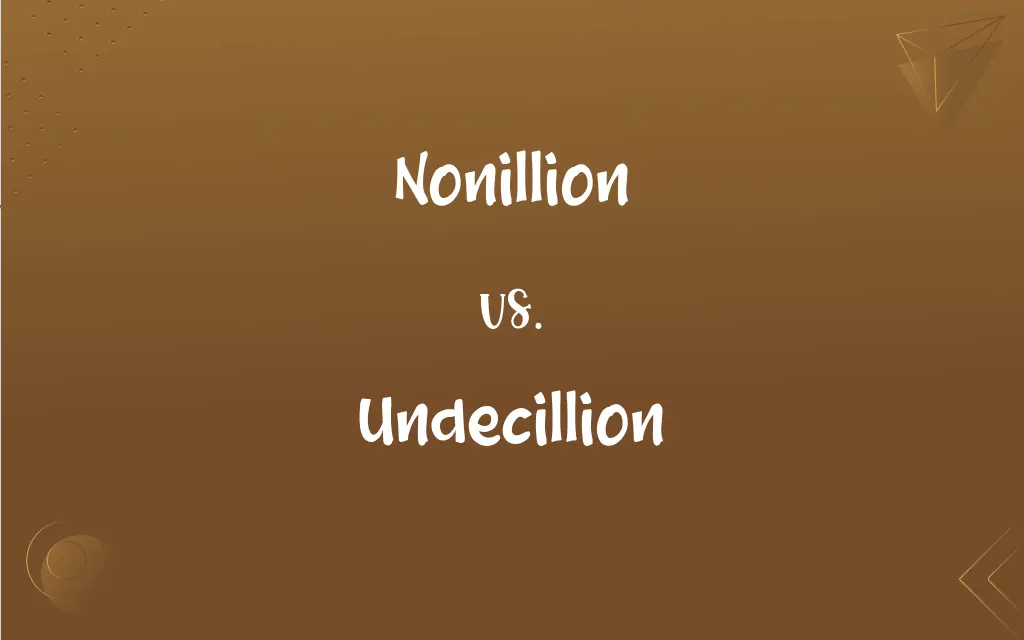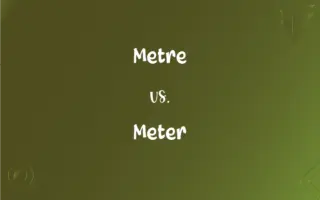Nonillion vs. Undecillion: What's the Difference?
By Janet White || Updated on May 22, 2024
Nonillion is a number with 30 zeros in the American system, while undecillion is a number with 36 zeros. Both represent large quantities in the realm of mathematics.

Key Differences
Nonillion is a term used to denote a number with 30 zeros following the 1 in the American numerical system. This means nonillion is equal to 10^30. In various scientific contexts, such as astronomy or chemistry, nonillion is used to express extremely large quantities or measurements. Undecillion, on the other hand, represents a number with 36 zeros following the 1 in the American numerical system, equivalent to 10^36. It is even larger than nonillion and is used in similar scientific contexts where even larger magnitudes are required.
n comparison, nonillion is significantly smaller than undecillion. Specifically, nonillion is one million times smaller than undecillion. This substantial difference means that while both are used to describe large quantities, undecillion is used for measurements or counts that are far greater.
Nonillion and undecillion are part of a naming convention that progresses systematically by adding specific prefixes to the "-illion" suffix. Nonillion uses "nona-" for nine, and undecillion uses "undeca-" for eleven, reflecting their positions in the sequence.
While nonillion finds its application in scenarios requiring the expression of large-scale numbers, undecillion is reserved for even more extensive calculations and measurements. Both terms showcase the expansive nature of numerical representation in mathematics and science.
Comparison Chart
Number of Zeros
30
36
ADVERTISEMENT
Scientific Notation
10^30
10^36
Prefix Origin
Latin "nona-" (nine)
Latin "undeca-" (eleven)
Comparative Size
1 million times smaller than undecillion
1 million times larger than nonillion
Usage Context
Large-scale scientific measurements
Extremely large-scale calculations
Nonillion and Undecillion Definitions
Nonillion
The cardinal number representing 10^30.
A nonillion grains of sand might exist in all the beaches of the world.
ADVERTISEMENT
Undecillion
A number equal to 1 followed by 36 zeros.
The observable universe might contain undecillions of particles.
Nonillion
Used to describe very large quantities in various fields.
Theoretical physicists sometimes calculate with nonillions of particles.
Undecillion
Used for representing very large values in scientific research.
Theoretical mathematics occasionally deals with undecillions of possibilities.
Nonillion
In mathematics, a large number used in theoretical calculations.
The total number of possible DNA sequences can be expressed in nonillions.
Undecillion
A numeral indicating one followed by 36 zeros.
Some theoretical models predict numbers as large as an undecillion.
Nonillion
A number equal to 1 followed by 30 zeros.
The distance to some distant stars can be measured in nonillions of kilometers.
Undecillion
The cardinal number representing 10^36.
Undecillion is a term often used in hyper-large computations.
Nonillion
A numeral representing one followed by 30 zeros.
Scientists often deal with numbers as large as a nonillion in cosmology.
Undecillion
In mathematics, it signifies an extremely large quantity.
Counting to an undecillion would take an astronomical amount of time.
Nonillion
The cardinal number equal to 1030.
Undecillion
The cardinal number equal to 1036.
Nonillion
Chiefly British The cardinal number equal to 1054.
Undecillion
Chiefly British The cardinal number equal to 1066.
Nonillion
1030.
Undecillion
(US; modern British & Australian, short scale) 1036.
Nonillion
(dated British & Australian, long scale) 1054.
Undecillion
(dated British & Australian, long scale) 1066.
Nonillion
(hyperbole) An unspecified very large number.
Nonillion
According to the French and American notation, a thousand octillions, or a unit with thirty ciphers annexed; according to the English notation, a million octillions, or a unit with fifty-four ciphers annexed. See the Note under Numeration.
FAQs
Which is larger, nonillion or undecillion?
Undecillion is larger than nonillion.
How does nonillion compare to undecillion?
Nonillion is one million times smaller than undecillion.
Where is the term nonillion used?
It is used in large-scale scientific measurements and theoretical calculations.
How many zeros are in an undecillion?
An undecillion has 36 zeros, written as 10^36.
Is nonillion a common term?
It is uncommon and used in specific scientific contexts.
Can you provide an example of nonillion?
e.g., The nonillionth place in a large number sequence.
What is an example of undecillion?
e.g., There might be undecillions of stars in the multiverse.
What is a nonillion?
A nonillion is a number with 30 zeros, represented as 10^30.
What is the origin of the term undecillion?
It comes from the Latin prefix "undeca-" meaning eleven.
What fields might use undecillion?
Advanced theoretical physics and large-scale cosmological calculations.
What is the practical use of nonillion?
It helps in quantifying extraordinarily large numbers in scientific research.
What is a practical use of undecillion?
It serves to express even larger quantities in theoretical models.
Are nonillion and undecillion part of a sequence?
Yes, they follow a systematic numerical naming convention.
Is undecillion commonly used?
It is very rarely used due to its extremely large value.
How to recall the size of undecillion?
Remember it as 1 followed by 36 zeros.
How is nonillion written in scientific notation?
As 10^30.
How is undecillion written in scientific notation?
As 10^36.
What field uses nonillion?
Fields like astronomy, cosmology, and theoretical physics.
How to remember the size of nonillion?
Think of it as 1 followed by 30 zeros.
What is the next number after undecillion?
The next number is duodecillion, which has 39 zeros.
About Author
Written by
Janet WhiteJanet White has been an esteemed writer and blogger for Difference Wiki. Holding a Master's degree in Science and Medical Journalism from the prestigious Boston University, she has consistently demonstrated her expertise and passion for her field. When she's not immersed in her work, Janet relishes her time exercising, delving into a good book, and cherishing moments with friends and family.
































































